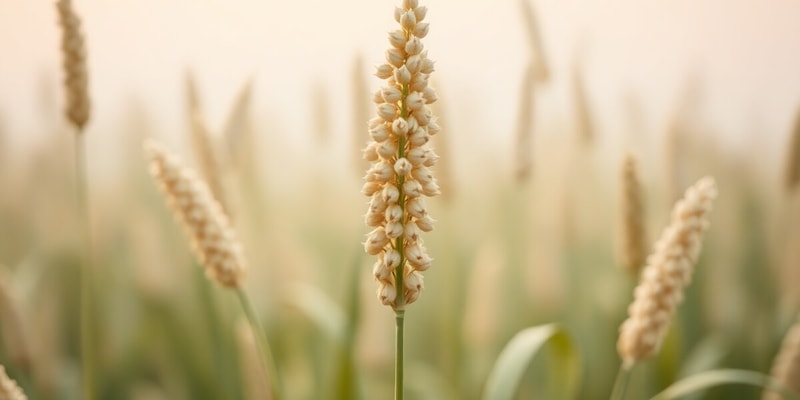Podcast
Questions and Answers
What is the term for the grass fruit with a firmly adherent pericarp?
What is the term for the grass fruit with a firmly adherent pericarp?
What are the grains from non-Poaceae species known as?
What are the grains from non-Poaceae species known as?
What is the main advantage of cereals as a food?
What is the main advantage of cereals as a food?
How are cereal grains usually processed for human food?
How are cereal grains usually processed for human food?
Signup and view all the answers
What is the common use of millets and sorghums in Europe and North America?
What is the common use of millets and sorghums in Europe and North America?
Signup and view all the answers
What is the name of the Roman goddess of agriculture after whom cereals are named?
What is the name of the Roman goddess of agriculture after whom cereals are named?
Signup and view all the answers
When did the Chinese first cultivate rice?
When did the Chinese first cultivate rice?
Signup and view all the answers
What is the primary source of human energy for nearly 1.6 billion people?
What is the primary source of human energy for nearly 1.6 billion people?
Signup and view all the answers
What is removed from the grain during the polishing process?
What is removed from the grain during the polishing process?
Signup and view all the answers
What is the main factor that influences the protein content of rice?
What is the main factor that influences the protein content of rice?
Signup and view all the answers
What is the primary characteristic that affects the cooking quality of rice?
What is the primary characteristic that affects the cooking quality of rice?
Signup and view all the answers
Which of the following countries is NOT among the top rice producers?
Which of the following countries is NOT among the top rice producers?
Signup and view all the answers
Study Notes
Cereals
- Cereals are named after Ceres, the Roman goddess of agriculture, and are cultivated members of the Poaceae family.
- Cereals are grown for food, drink, and animal feed, with their seeds or grains being the main product.
Types of Cereals
- Three groups of cereals are recognized: major cereals, minor cereals, and wild cereals.
- Wild cereals refer to the edible seeds of wild grasses.
- Pseudocereals are grains from non-Poaceae species, such as Amaranthaceae, Chenopodiaceae, and Polygonaceae.
Characteristics of Cereals
- Cereals are energy-rich, easily grown, stored, and prepared.
- They can be stored throughout the year, making them available at all times.
- Cereal grains are usually ground to a flour for making bread or other cook products.
- They can also be processed for breakfast cereals, or fermented or distilled for alcoholic beverages.
Regional Differences in Cereal Use
- Regional differences exist in cereal use, with millets and sorghums being staple foods in Africa and Asia, while in Europe and North America, they are grown chiefly for feeding to livestock and poultry.
Rice
- Rice is the second most important cereal in terms of global production.
- It is a staple diet for close to 1.6 billion people and is the primary source of human energy.
- Rice differs from other cereals in that it is usually cooked and eaten boiled as a whole grain and not milled.
- There are 7000 varieties of rice planted around the world.
- The Chinese were the first to cultivate rice (approximately 4000 B.C.).
- Rice is associated with low-income earners and poverty.
Nutrition and Processing of Rice
- Polishing removes the thiamine (vitamin B1) from the outer layers of the grain, leading to thiamine deficiency and beriberi.
- Polished rice has its pericarp removed/destroyed, resulting in loss of nutrients.
- Throwing away the gruel after cooking results in further loss of nutrients.
- Brown rice is less popular than polished rice because it requires more time for cooking and consequently more fuel.
- Rice contains 70 to 80% starch, 7% protein, 1.5% oils, some vitamins (mainly A, B, and C), and some essential minerals.
Quality of Rice Grain
- Grain appearance is assessed in terms of moisture content, grain size, shape, colour, gloss, translucency, uniformity, cleanliness, and freedom from empty hulls, straw, and other seeds.
- Milling quality is based on the yield of whole grain after the milling process has removed the hull, bran, and germ with minimum breaking of the endosperm.
- Cooking quality varies according to ethnic and regional preferences, and is associated with grain size and shape.
- The two most important physiochemical cooking properties are gelatinization temperature and amylase content.
Studying That Suits You
Use AI to generate personalized quizzes and flashcards to suit your learning preferences.
Description
Learn about the different types of cereals, their classification, and characteristics. Discover the botanical terms used to describe the grain and fruit of various cereals.




